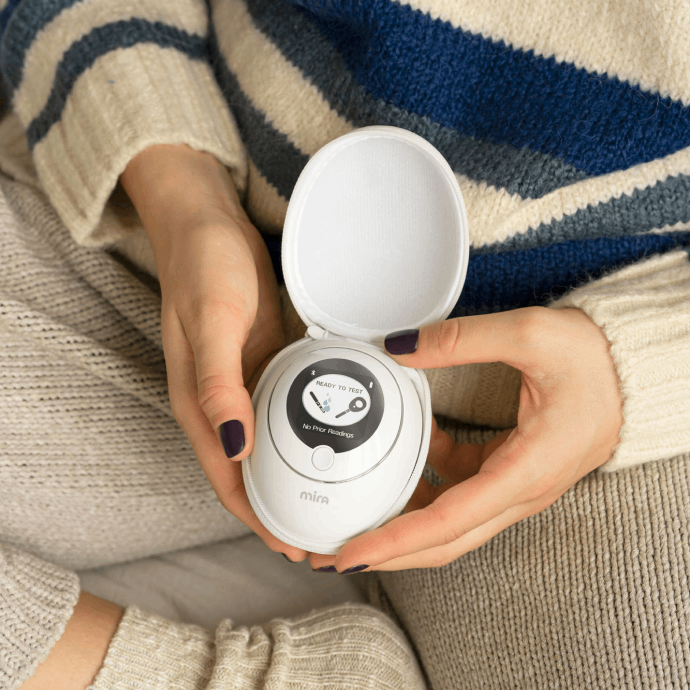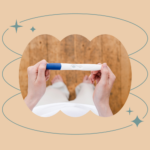When to Take a Pregnancy Test Based on Science and Ovulation
When you are trying to conceive (TTC), the infamous two-week wait can feel like it goes on forever. You want to know if you are pregnant ASAP — but you also know that failing to wait the appropriate amount of time could result in a false-negative result.

Even if you know the science behind ovulation, it’s tough to resist the temptation to test early. You might find yourself browsing the internet endlessly for things like “when to take a pregnancy test,” or scanning the drugstore shelves for sophisticated tests that claim to offer the fastest and most accurate results in the hope of shortening that two-week wait.
You might wonder: do I really have to wait that long to take a pregnancy test? The answer is yes. Waiting at least two weeks before taking a pregnancy test gives you the most accurate results — and might save you some unnecessary disappointment.
Don’t believe us? Here’s the science behind why the two-week wait works:
Does it matter when you take a pregnancy test?
In short, yes. You might be excited to find out if you’re really pregnant or not, but taking a pregnancy test too early can lead to a false-negative result. You might also get a false-positive result if you forget to take a second pregnancy test a couple of days after receiving a positive result.
Home tests have limited accuracy (as low as 75%), so you’ll want to do everything you can to maximize the efficacy of your pregnancy test. Waiting the appropriate amount of time before testing ensures that you’re getting the most accurate results from whichever test you choose.
Understanding your options: When is the best time to take a pregnancy test?
Sometimes, you may be unsure whether it’s too early to take a pregnancy test. Other times, you might have symptoms like a late period or breast tenderness but wonder if it’s worth waiting before making a trip to the drugstore.
There are a few different ways to determine the best time to take a pregnancy test. This is what science has to say about when you should and should not test:
Based on your cycle
Ideally, you should wait until the first day of your next expected period to take a pregnancy test. If you test several days before your period, you are likely to get a negative result, although you can still be pregnant.
Take a home pregnancy test (HPT) at least one day after the estimated start date of your next period. If you have a 28-day cycle, wait until:
- 29 days after the first day of your last period
- 14 days past ovulation (DPO)
If you aren’t tracking your cycle, there are many benefits to doing so. Using Mira’s fertility kit can help you know when you ovulate by tracking your precise LH levels. Combined with AI personalized cycle prediction, this helps you test at the right time.
Based on ovulation
In addition to waiting until the first day of your expected period, it is recommended to take a pregnancy test no earlier than 12 days past ovulation (DPO).
The time to take an early pregnancy test is linked to when ovulation occurs and when implantation occurs.
While it is often believed ovulation occurs 14 days before the onset of your next period, the actual ovulation day varies from woman to woman and cycle to cycle (more on early ovulation here). This is why it is important to track your ovulation using a product like Mira when you are trying to conceive.
Implantation takes place after an egg is released into the fallopian tube, fertilized by sperm, and implanted itself into the uterine wall, where prenatal development starts. Technically, implantation is supposed to happen at 9 days after ovulation. But the actual range is 6 – 12 DPO, and 84% occurs between 8 – 10 DPO.
The fertilized egg doesn’t produce the pregnancy hormone human chorionic gonadotropin or hCG until it is fully implanted in the uterine wall.
Once the implantation is complete, levels of hCG start to double about every 48 hours.
However, the hCG baselines and hCG doubling pattern differ greatly from woman to woman. Pregnancies of the same woman can have different hCG levels too. Together with the timing of ovulation and implantation, these factors affect when you should take a pregnancy test and expect to get a positive result.
If you feel pregnant
Sometimes, you may begin to experience symptoms of pregnancy before the two-week wait is over. Some of the early symptoms of potential pregnancy (besides a missed period) include:
- Tender or swollen breasts
- Nausea and/or vomiting
- Increased urination
- Fatigue
- Feeling “different” than before
You can take a pregnancy test if you are experiencing symptoms but should know that you may receive a false-negative result.
There is also such a thing as a chemical pregnancy, which is an early pregnancy loss happening shortly after implantation.
One week after ovulation, the fertilized egg implants itself into the uterine wall. It starts to produce levels of the pregnancy hormone hCG. You may receive a positive pregnancy test result at this time. However, for some reason, the implantation may not develop, resulting in a negative pregnancy test a few weeks later. Usually, you will not have any other signs of pregnancy with a chemical pregnancy, but that does not mean it is impossible.
Chemical pregnancies are common, accounting for 50-60% of first-time pregnancies. A chemical pregnancy is mostly caused by chromosomal abnormalities.
You may have a positive pregnancy test result from a chemical pregnancy if you test too early, which technically is not a false-positive result given you were pregnant. You can avoid the positive test result from a chemical pregnancy by testing no earlier than the first day of your missed period.
Getting it right: Understanding pregnancy test details
Details matter when it comes to getting an accurate pregnancy test result. Taking a pregnancy test at the wrong time, or using a pregnancy test incorrectly, can result in a false-negative or false-positive result.
The results from home pregnancy tests are up to 99% accurate the day after a missed period but may be less accurate at other times. Range in accuracy is due to a few factors:
- Correct use of a home pregnancy test.
- Knowing the first day of your last period.
- Knowing your ovulation and menstruation cycle dates.
How Pregnancy Tests Work
Home pregnancy tests detect a hormone called human chorionic gonadotropin (HCG) in urine. Your body doesn’t produce hCG until a fertilized egg attaches during implantation. This usually happens between 7 to 12 DPO.
There are standard hCG levels for the first few weeks of pregnancy. The weeks below are based on the first day of your last menstrual period (LMP):
- 3 weeks – 5 – 50 mIU/mL
- 4 weeks – 5 – 426 mIU/mL
- 5 weeks – 18 – 7,340 mIU/mL
- 6 weeks – 1,080 – 56,500 mIU/mL
Pregnancy tests use a minimum level of hCG to detect positive results. There are some important figures about hCG detection you should know:
- hCG total range detection – 10 mIU/mL to 100 mIU/mL
- hCG average detection – 25 to 50 mIU/mL
- hCG early result test detection – 25 mIU/mL
These test statistics include digital tests and early pregnancy tests. Medical professionals say a positive pregnancy is 25 mIU/mL of hCG or more. From the numbers you read above, you see why waiting is the best option.
If you take a home pregnancy test too early, you may end up with a false-negative result, which means, in fact, you are pregnant, but the test returned a negative result.
It is simply because your hCG hormone hasn’t reached the threshold of the pregnancy test yet. Wait until the day of your missed period, or 1-2 days later, as your period could be late. This will prevent a false-negative test result and save you money.
When is a pregnancy test most accurate?
Some times of day are better than others for taking a home pregnancy test. If you are testing before your period is due, you should test with morning urine, which has a higher concentration of hCG. You can test any time during the day if you have passed the day of your missed period. By then, your hCG level should be high enough to be detected if you are pregnant.

Tips for Taking a Pregnancy Test
Using a home pregnancy test is pretty easy. All HPTs are urine tests and often use a testing stick you hold in your urine stream. Here’s how to use a home pregnancy test the right way:
- Purchase a test and check the expiration date on the box.
- Read test instructions and follow them carefully.
- Use your first urine of the day for the highest hCG concentration.
- Read the results based on test instructions.
If you’re not sure you tested correctly, simply take another test. Many HPTs come in packages of two or three. Buy multi-packs if you’d prefer to double-check test results.
The accuracy of a home pregnancy test can vary, depending on how you use it and your menstrual cycle. To improve the accuracy of a home pregnancy test, you will want to pay attention to the following details:
- Testing too early. You shouldn’t test earlier than 12 DPO. It is best to wait until your period is due.
- Urine is diluted. You are not using morning urine or drinking too much fluid before the test. The hCG concentration in your urine is diluted.
- Not enough waiting time. The US Office of Women’s Health recommends waiting up to 10 minutes after the test to check the results. This time frame will give you the most accurate result.
- The test is not sensitive enough. Some pregnancy tests are more sensitive than others. If you want to detect pregnancy early, ask the pharmacist for a more sensitive brand.
For the best results from a home pregnancy test, you should understand how pregnancy tests work — and why they may not work properly if you take a pregnancy test too early or in the wrong way.
Types of Pregnancy Tests
There are many types of pregnancy tests available. Doctors often order a blood test to understand your hCG levels. You can also buy a home pregnancy test to measure hCG levels in urine.
Home Pregnancy Tests
A home pregnancy test is usually the first step in determining whether or not you could be pregnant. There are three types of home pregnancy tests:
Traditional pregnancy tests or “sticks” measure levels of hCG in your urine. They have a window with a pink “test line” that will appear once your urine has soaked into the test strip. If you are pregnant, a second pink line will appear in the window. Because the pregnancy line can be faint, it is sometimes more difficult to interpret a traditional pregnancy test.
Digital pregnancy tests detect pregnancy in the same way: by measuring levels of hCG in your urine. However, digital pregnancy tests can provide more accurate results using a method called “rapid assay delivery,” which can give simple yes or no results in as little as three minutes (which are easier to interpret than those little pink lines) — and even tell you if the pregnancy test may not have been accurate.
Early pregnancy tests are traditional or digital pregnancy tests that can be used several days before the first day of your expected period. Some brands can detect hCG levels in more than 75% of women, five days before their expected period. However, early pregnancy tests are not accurate for everyone. Some women may not have detectable levels of hCG in their urine at the time they took the test. If you receive a negative early pregnancy test result, it is worth waiting until the first day of your expected period to take a second pregnancy test.
Blood Pregnancy Tests
Your doctor may perform a blood test to determine whether or not you are pregnant. A quantitative test measures the level of hCG in your system, and qualitative tests measure the presence of hCG. Quantitative tests are used for monitoring increased or decreased hCG levels in early pregnancy.
Home pregnancy tests can be up to 99% accurate. However, if you’re uncertain about home test results, or want to verify them, it is a good idea to schedule an appointment with your OBGYN. It’s also important to make an appointment for a blood pregnancy test if:
- Your HPTs are negative, and you’ve missed three cycles.
- You suspect you may have a health issue causing false results.
- You have a history of miscarriages or ectopic pregnancies.
Common Questions about Pregnancy Tests
When you are TTC, you want the best results possible to ensure that your home pregnancy test is accurate. After all, it can be disappointing to receive a false-positive or false-negative result or to learn that a positive test result was the result of a chemical pregnancy. As a result, you may have a lot of questions about taking a home pregnancy test. We answer some of your most burning questions about HPTs below:
How early can you take a pregnancy test?
You should take a pregnancy test no earlier than 12 DPO. Some brands of HPTs may claim to provide results as early as six days before the start of your expected period. However, these results may not be as accurate and can result in a false-negative or a positive result from a chemical pregnancy. You can prevent this by sticking to the recommendation of testing no earlier than 12 DPO.
How soon will a pregnancy test read positive?
In some women, early pregnancy test results can read positive as early as five days before their expected period — but it’s important to understand that an early positive result from a pregnancy test may be from a chemical pregnancy, rather than a viable one. Additionally, not all women will have detectable hCG levels this early in their pregnancy. Therefore, you should still wait 12 days DPO to take a pregnancy test for the most accurate results.
Do you take a pregnancy test in the morning or at night?
The best time of day to take a pregnancy test is in the morning, with your first urine of the day. The hCG levels in your urine are highest at this time of day and most likely to be detected by an HPT. However, if you are testing past the first day of your expected period, you may still receive a positive test result if you take a pregnancy test at night. This is because hCG levels are high enough to be detected at any time of day.
Mira’s Editorial Process
All content produced by Mira meets stringent editorial standards, ensuring excellence and accuracy in language and medical precision. Every piece undergoes thorough fact-checking and review by qualified professionals. Check out our full editorial process to learn more.










